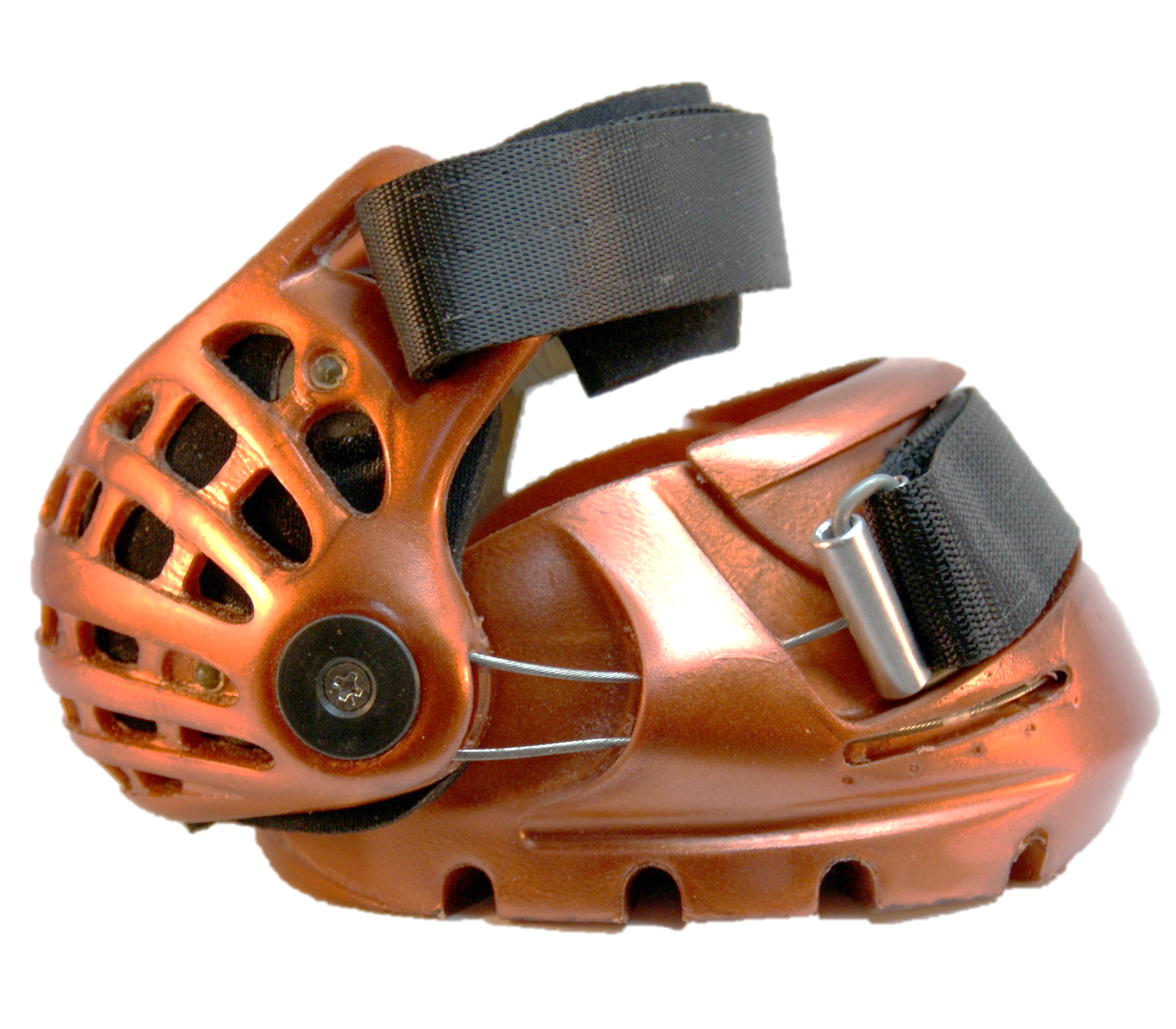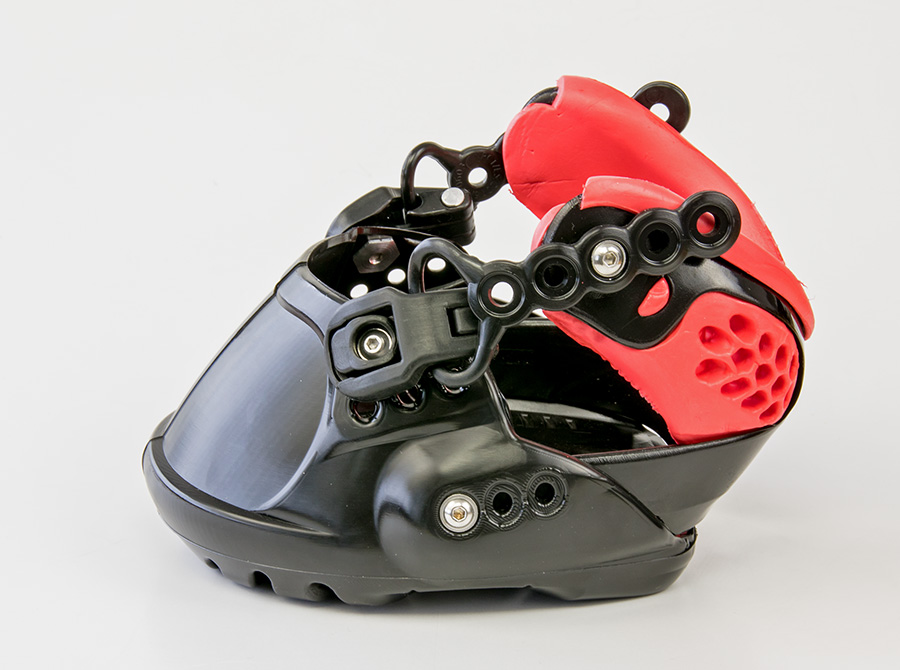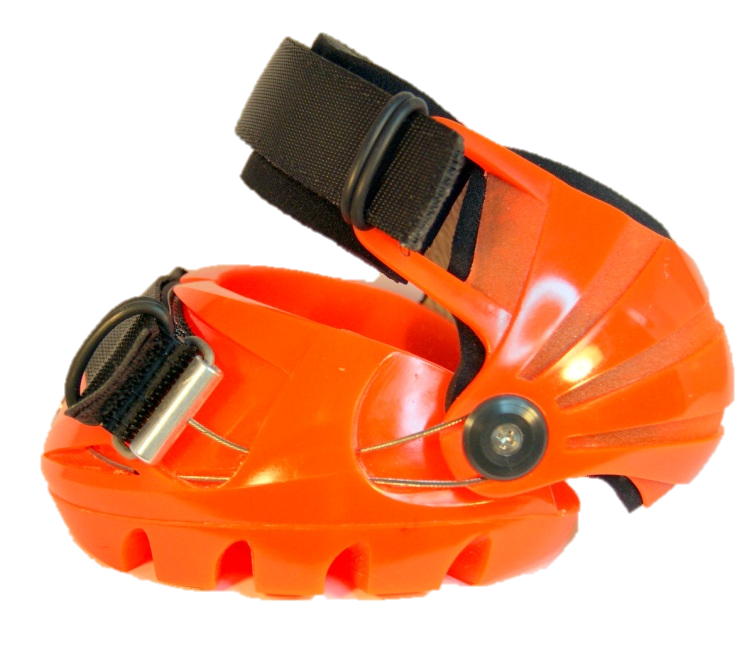




Hoof boots provide comfort for horses new to barefoot. Imagine yourself without your shoes – not too bad when your in your house, but when going outside on the footpaths and roads, it can be pretty uncomfortable. Then imagine walking on stones, and then carrying extra weight!
It’s no different for your horse. While in his paddock he is comfortable, but then we ask him to go over terrain that his hooves are not accustomed to, whether carrying our weight or not he is likely to be tender over the harder surfaces and rocks and be uncomfortable. His hooves simply aren’t accustomed to the harder terrain.
It’s not about making the horse ‘tough it out’. The hoofs will not transition to barefoot performance under these conditions.
This is where hoof boots come in, they help your horse to move easily over terrain he would otherwise be reluctant to travel on. The key here is that the horse will be more comfortable and use his hooves correctly – landing heel first, flexing the hoof at the frog and rolling over at the toe. This promotes good blood flow circulation within the hoof capsule, helping improve the whole hoof. Over time naturally trimmed hooves will grow thicker walls and soles, build calloused frogs and hoof boots may then only be needed occasionally. The more riding you do the quicker the hooves will become like steel, and the faster they will grow.
Riding a horse that is uncomfortable will encourage a toe first landing, and this has an adverse effect on the mechanics of the hoof. Boots should be used during the transition period, particular after metal shoes are removed and when riding is not regular enough to keep the hooves hardened and calloused.
Usually boots are only needed on the fronts, however on longer rides or rides over several days that your horse is not accustomed to, he will likely become sore or uncomfortable on his hinds. So if you are going to do anything out of the usual, consider booting all 4 hooves.
Boots are really coming into their own now, there are more and more designs coming on the market, some are easier to use than others, some are high performance and some have spare parts available to keep them ‘on the road’ longer. But there will never be one boot that will suit every horse, and some horses hoof shape and size may limit the choices you have.
As a guide only, using boots for a few hours each week you can expect to get a years wear from one pair of boots – so while they may seem pricey at first, when compared with shoeing over the same period of time they work out extremely cheap, even more so if you undertake a course to learn to trim and maintain the hooves yourself, getting a professional in occasionally to check your work if you need.
Don’t hesitate to contact us if you have any questions.

Horse Venue Biosecurity Workbook
A self-evaluation guide for managers of all horse venues including racecourses, showgrounds, riding and pony club venues, agistment properties and horse events.
Download HERE
Taking your horses digital pulse
Thank you to Horses and People Magazine for producing this useful instruction sheet on taking your horses digital pulse.
(You can download your own copy here how-to-digital-pulse)
Hoof boots – for what reason….?
Hoof boots provide comfort for horses new to barefoot. Imagine yourself without your shoes – not too bad when your in your house, but when going outside on the footpaths and roads, it can be pretty uncomfortable. Then imagine walking on stones, and then carrying extra weight!
It’s no different for your horse. While in his paddock he is comfortable, but then we ask him to go over terrain that his hooves are not accustomed to, whether carrying our weight or not he is likely to be tender over the harder surfaces and rocks and be uncomfortable. His hooves simply aren’t accustomed to the harder terrain.
It’s not about making the horse ‘tough it out’. The hoofs will not transition to barefoot performance under these conditions.
This is where hoof boots come in, they help your horse to move easily over terrain he would otherwise be reluctant to travel on. The key here is that the horse will be more comfortable and use his hooves correctly – landing heel first, flexing the hoof at the frog and rolling over at the toe. This promotes good blood flow circulation within the hoof capsule, helping improve the whole hoof. Over time naturally trimmed hooves will grow thicker walls and soles, build calloused frogs and hoof boots may then only be needed occasionally. The more riding you do the quicker the hooves will become like steel, and the faster they will grow.
Riding a horse that is uncomfortable will encourage a toe first landing, and this has an adverse effect on the mechanics of the hoof. Boots should be used during the transition period, particular after metal shoes are removed and when riding is not regular enough to keep the hooves hardened and calloused.
Usually boots are only needed on the fronts, however on longer rides or rides over several days that your horse is not accustomed to, he will likely become sore or uncomfortable on his hinds. So if you are going to do anything out of the usual, consider booting all 4 hooves.
Boots are really coming into their own now, there are more and more designs coming on the market, some are easier to use than others, some are high performance and some have spare parts available to keep them ‘on the road’ longer. But there will never be one boot that will suit every horse, and some horses hoof shape and size may limit the choices you have.
As a guide only, using boots for a few hours each week you can expect to get a years wear from one pair of boots – so while they may seem pricey at first, when compared with shoeing over the same period of time they work out extremely cheap, even more so if you undertake a course to learn to trim and maintain the hooves yourself, getting a professional in occasionally to check your work if you need.
Don’t hesitate to contact us if you have any questions.
JB’s story – Laminitis rehab story
CLICK HERE to see in full screen mode. Use your browser back button to return here.
Horses and hay bellies
Do your horses have a hay belly and yet you feel you hardly feed them anything? Here is a very interesting article written by Dr Eleanor Kellon which might help to explain why. Click on Let them Eat Hay
Horses and Climate Change
Have you thought about the impact of Climate Change on your horse and his environment? HorseSA facilitated a very informative workshop in 2012, published in the link below. There was also an article about it in the RIRDC Newsletter (link below also). As time goes on there will be much more to come on the subject – links will be added.
HorseSA – and climate change workshop Jun 12
Check this link for further workshops/developments HorseSA – Future Proof your Horse
RIRDC Newsletter Dec 2012
Rebecca Cassell – Climate Change and the Horse Nov 2013
Rural Industries Fact Sheet 2012
Impact of Climate Change on Horses – Melissa Rebbeck 2012
The impact of climate change on horses
Horses, Trains and climate change. 2016
Two wonderful little books with heaps of info
Two fantastic publications by Marg Richardson (www.thefunctionalhoof.com) and Jen Clingly (www.wildabouthooves.com.au).
The Bare Facts – is packed with information on the horse, the environment and feed – as we know unless the movement, feed and environment is right, your horse will struggle to get the hoof he needs. This little book gives you ideas and suggestions to help you get the balance right.
Founder Facts – is helpful for the owner/carer of suffering horses. This book needed to happen. So enlighten yourself with the information packed in this little book.
The books are just $14 for the pair from the shop. Proceeds from the sale of the books will be directed back to the authors so they can continue to bring us informative helpful information! Purchase here
The Functional Hoof Conference 2011
1st to the 5th February at Melbourne Veterinary University, Werribee.
If you attended the Conference then there is no reason for you to read any further, as you will know what I am about to say.
What an interesting, informative, educational and very open forum for the discussion about our Equine friends. If you missed it you would be sorry, there was just so much that came out of it to even attempt to fill you in. It was very interesting to listen to very notable and informative professors, scientists, inventors and veterinarians, all putting their views forward, and listening to case studies from those on the ground working with horses. It’s incredible the amount of research going into our equine friends, and with so many hours and minds combined, only good can surely come of it.
It was a star studded line up – and keep watching because we are going to hear their names more and more in the future.
One thing was agreed on by all – you can be the best hoof carer in the world, but unless the feed, environment and movement is right, you won’t ever get the hoof you are looking for just by trimming.
The speakers/presenters at the conference consisted of the following, and there were a number of case studies presented also:-
It was a very in depth, comprehensive and brain spinning conference. There’s talk of another one, probably in two years or so which might be held in another country. So start saving, it’s something you don’t want to miss.